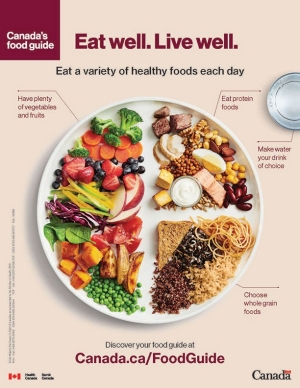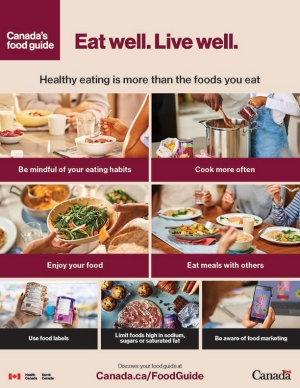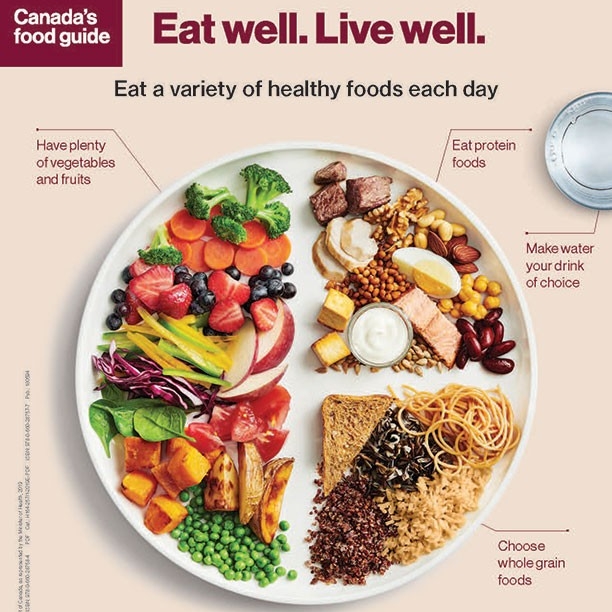article
Summary of Canada's Food Guide
Canada's Food Guide
Canada’s Food Guide is a document from Health Canada that provides guidelines for healthy eating.
Canada's first food guide, the Official Food Rules, was introduced to the public in July 1942. Over the years the recommendations in the Food Guide have evolved to reflect emerging research in the field of nutrition. The most recent version of the Food Guide was released in February 2019.
Canada's Food Guide emphasizes a healthy eating pattern. There are two central messages:
- Consume a diet that consists mainly of plant foods (e.g., fruit, vegetables, whole grains, nuts, seeds, beans, lentils, soy).
- Choose whole foods and minimally processed foods often. Limit highly processed foods, which include sugary drinks, fast foods and deli meats. Whole foods have not been processed (i.e., changed); minimally processed foods have been changed slightly.
Below is a summary of the recommendations in the Food Guide. To learn more, consult the Food Guide website.
Eat a variety of healthy foods each day
Eat plenty of vegetables and fruit
The Food Guide recommends that about half (50%) of the foods you consume each day come in the form of vegetables and fruit. Some ideas to get more vegetables and fruit in your diet are presented in 16 ways to get more plant foods into your diet. To discover how to cook vegetables consult basic kitchen and cooking skills, which includes video instructions on how to grill, roast, steam and stir fry vegetables.
Choose whole grain foods
The Food Guide recommends that about a quarter (25%) of the foods you consume each day are grain foods, with an emphasis on whole grain foods, which are a healthier choice than refined (i.e. processed) grains. Grains include wheat, rice, quinoa, oats and rye. Consult cooking with whole grains to learn how to cook whole grains. Products made from grains include breads, cereals, noodles and crackers.
Eat protein foods
The Food Guide recommends that about a quarter (25%) of the foods you consume each day come from protein foods. Choose protein foods that come from plants more often. These include beans, peas, lentils, soy products (e.g., tofu), nuts and seeds. Protein foods that come from animals include meats (e.g., chicken, turkey, pork and beef), eggs, fish, shellfish and dairy products (e.g., yogurt and cheese). Choose lower-fat versions of animal products (e.g., low-fat yogurt, lean meats).
Make water your drink of choice
There are plenty of beverage options out there. Unfortunately, many have a lot of sugar and calories. Some beverages are high in salt or fat. Make water your drink of choice. It is a great way to quench your thirst and to stay hydrated without calories.
Use food labels
Food labels provide information that can help identify healthy foods. Information on labels include the “Nutrition Facts” panel, the ingredient list and nutrition claims. See how to read a food label for more information.
Limit foods high in sodium, sugars or saturated fat
High levels of added sugars, sodium (e.g., salt) and saturated ("bad") fat in the diet are associated with a range of health problems. Choose foods that are low in added sugars and low in sodium. Choose foods with healthy fats, which are predominantly plant foods such as nuts, seeds, avocadoes and plant oils such as canola, olive or corn oil. Fatty fish (e.g., salmon, trout, mackerel and sardines) contain healthy fats.
Be aware of food marketing
Food producers spend millions of dollars each year marketing their products to the public. They study us and know how to make their products appealing so that we will buy them. Unfortunately, the most highly marketed food and drink products are also some of the least nutritious (e.g., sodas, fast foods). Marketing affects your food choices so it is important to be aware of the strategies marketers use to promote their products.


Healthy eating is more than the foods you eat
Be mindful of your eating habits
Being mindful means being aware of how, what, why, when and where you eat. It can help you make healthier choices more often and make positive changes in your eating habits.
Cook more often
Many meals prepared outside of the home are high in sugar, sodium (e.g., salt) or fat. By cooking for yourself you can select whole ingredients and keep unhealthy nutrients (e.g., saturated fat) low. Basic kitchen and cooking skills has plenty of short cooking videos to help you become more confident in the kitchen.
Enjoy your food
Enjoying your food is part of healthy eating. Enjoy the taste of your food and the many food-related activities that go along with eating.
Eat meals with others
Enjoying healthy foods with family, friends, neighbours or co-workers is a great way to connect and add enjoyment to your life. It can provide many benefits and contribute to a healthy lifestyle.


